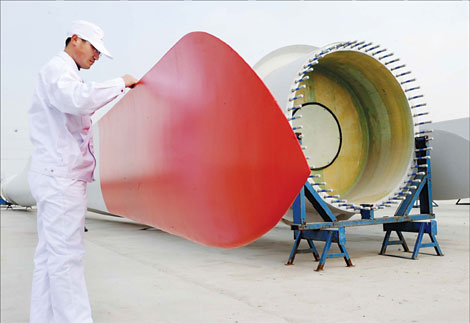Quest for green growth
Updated: 2011-06-03 11:06
By Fu Jing (China Daily European Weekly)
|
 A worker checks wind power equipment at a plant in Lianyungang, East China's Jiangsu province. Geng Yuhe / For China Daily |
China, EU step up efforts to forge clean energy path as both see opportunities in each other's market
Green alliances will be the framework of future international cooperation as more nations join the clean energy bandwagon and reshape their economic growth models. By successfully transforming its development into a more sustainable mode, China has leapfrogged most other nations in terms of green strides and also set the tone for others by adding green goals to its 12th Five-Year Plan (2011-2015).
"China's 12th Five-Year Plan has outlined massive investments in environmental protection and green growth," says European Council President Herman Van Rompuy.
That, in turn, should be sweet news for several European Union (EU) nations and companies as it offers lucrative business opportunities and jobs with promises of sustained growth.
China and the EU have been at the forefront of several green initiatives. But in recent times there have been indications that both sides are keen to step up the
|
 |
Song Zhe, China's ambassador to the EU, says China's five-year plan aims to promote use of clean energy and increase the share of non-fossil fuels in primary energy consumption.
"Europe, for long an advocate and forerunner of the green and recycling economy, is now well positioned to explore China's green market potential and achieve export-oriented growth in sectors related to new energy and environment," Song says.
China's green drive is also expected to further ties in addressing controversial issues like climate change. Through active coordination, particularly by jointly working out an energy-saving, planet-friendly economic growth model, Song says the two sides can help in securing sustainable natural environment and human development.
To achieve the targets of renewable energy, carbon intensity, energy efficiency, green transportation and environmental protection, policymakers in China are also chalking out detailed programs for each of these sectors.
Sustainable development seeks to meet the needs and aspirations of the present without compromising the ability to meet those of the future, the report explains.
In the five-year plan, China has revealed that renewable energy's ratio in the total energy mix will be 11.4 percent by 2015 and 15 percent by 2020. During the same period, the carbon intensity per unit of GDP will be reduced by 17 percent.
More significantly, China is also discussing the introduction of an energy target, which could cap its energy consumption at 4 billion tons of coal equivalent by 2015, or focus only on coal consumption or production capacity rather than total energy use.
Either cap could play an important role in supporting the increase in renewable energy use to 11.4 percent of total power generation in 2015, up from the current levels of just more than 9 percent.
The National People's Congress, China's top legislature, also approved plans to add 120 gigawatts (gW) of new hydroelectric capacity in the next five years as well as 70 gW of wind power and 5 gW of solar power. However, the targets are under review due to the recent nuclear crisis in Japan. Indications are that China's solar installation capacity may be boosted from 5 gW to 10 gW by 2015 and 50 gW by 2020.
E3G, a consultancy on sustainable development based in the United Kingdom, says in a recent report that the Chinese government is backing these goals with massive public investments in clean energy and infrastructure. Renewable energy capacity will match growth in the EU with installed capacity increasing by 64 percent to 427 gW by 2015, compared with 322 gW in the EU by 2015.
The report says that China will decisively out-invest the EU in grid infrastructure with 500 billion yuan (57 billion euros) allocated to ultra high voltage (UHV) transmission lines by 2015, and more than 4 trillion yuan will be spent on smart grids in the next decade.
On its part, the EU needs to ensure strong domestic demand for low-carbon goods and services by raising its own emission reduction targets to 30 percent by 2020, the report says.
E-paper

Pearl paradise
Dreams of a 'crazy' man turned out to be a real pearler for city
Literary beacon
Venice of china
Up to the mark
Specials

Power of profit
Western companies can learn from management practices of firms in emerging economies

Foreign-friendly skies
About a year ago, 48-year-old Roy Weinberg gave up his job with US Airways, moved to Shanghai and became a captain for China's Spring Airlines.

Plows, tough guys and real men
在这个时代,怎样才"够男人"? On the character "Man"
